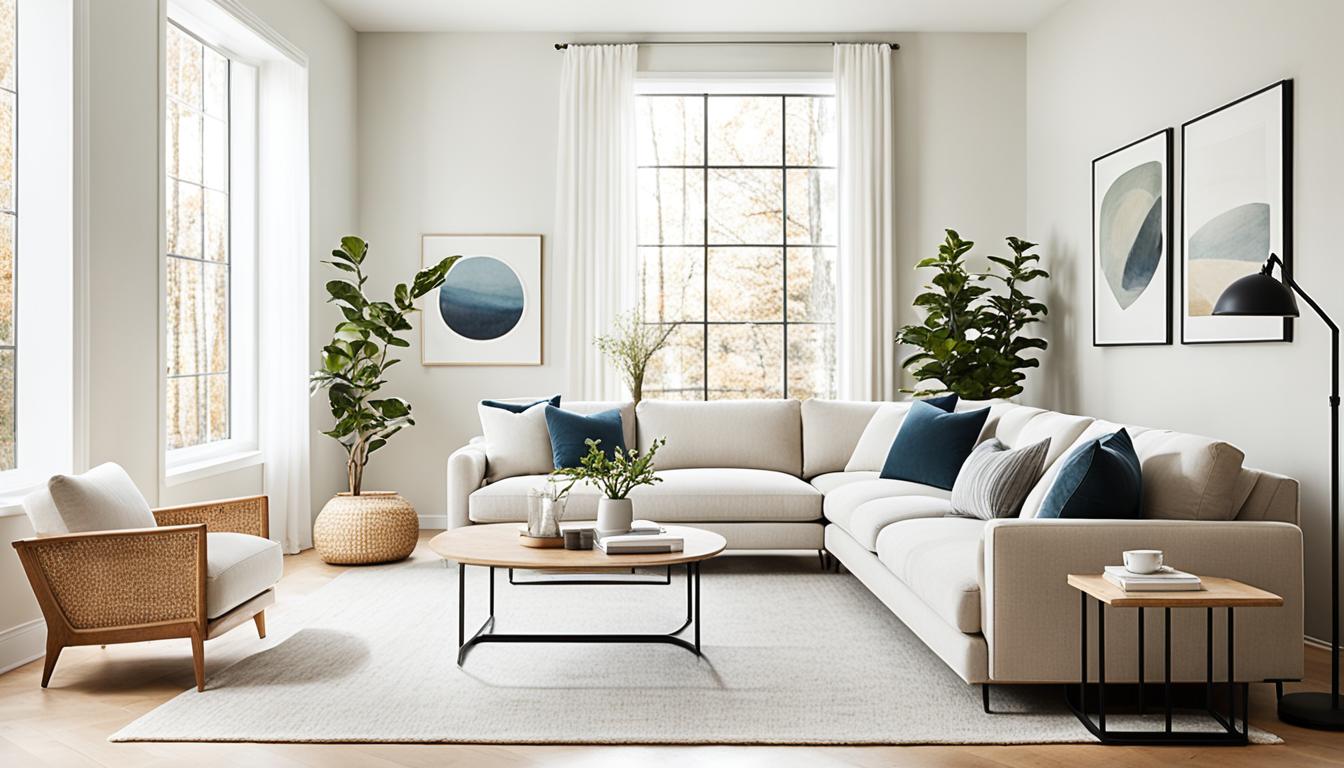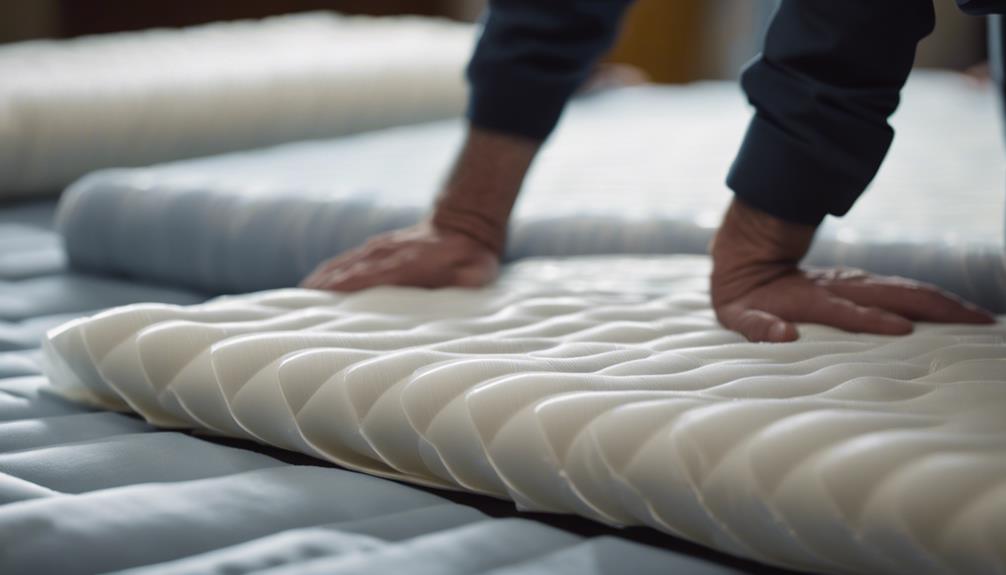Welcome to our essential styles guide for minimalist living rooms, where we explore the art of creating beautifully simplistic and clutter-free spaces. Are you ready to discover how minimalist design can transform your living room into a haven of tranquility and style?
Key Takeaways:
- A minimalist living room is designed to include only the essentials, promoting simplicity and reducing consumption.
- Key elements of a minimalist living room include comfortable seating, good lighting, window treatments for privacy and temperature control, a coffee table, built-in storage, rugs, minimal decor, simple wall art, and plants.
- Minimalist interiors are characterized by clean lines, ample natural light, and neutral color palettes, creating a calming and serene atmosphere.
- By embracing minimalism, you can enjoy the benefits of reduced stress, easier cleaning, and a visually appealing living space.
- Creating a minimalist living room involves decluttering, simplifying furniture choices, clearing surfaces and floors, incorporating minimalist artwork and decorations, choosing a subdued color palette, implementing effective storage and organization solutions, and maintaining a conscious approach to new acquisitions.
The Benefits of a Minimalist Home
When it comes to creating a peaceful and harmonious living space, a minimalist home offers a multitude of benefits. By embracing simplicity and minimalism, you can transform your living environment into a serene sanctuary that promotes both physical and mental well-being.
One of the primary advantages of a minimalist home is the reduction in stress levels. Clutter is a form of visual distraction that can overwhelm the mind and create feelings of chaos. By eliminating unnecessary items and keeping your space tidy and organized, you can free your mind from the burden of excess and create a soothing atmosphere.
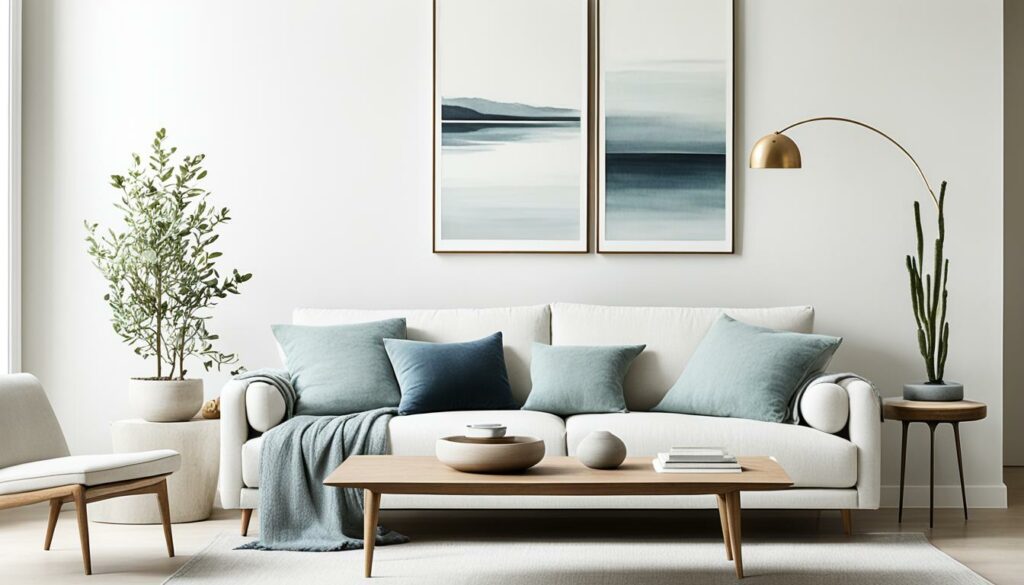
In addition to reducing stress, a minimalist home is highly appealing. The focus on simplicity and minimalism allows for a clean and uncluttered aesthetic that is both visually pleasing and inviting. The absence of excess allows the natural beauty of your space to shine through, creating a sense of calm and serenity.
“Minimalism is not about depriving yourself, but about creating an environment that allows you to focus on what truly matters in life.” – Marie Kondo
Furthermore, a minimalist home is much easier to clean and maintain. With fewer belongings and a simplified layout, you won’t waste valuable time and energy on constant upkeep. Cleaning around furniture and finding storage solutions becomes effortless, allowing you to spend your time on activities that bring you joy and fulfillment.
Overall, adopting a minimalist home not only enhances the aesthetics of your living space but also improves your overall well-being. By reducing stress, promoting simplicity, and facilitating easier maintenance, a minimalist home creates a peaceful and harmonious environment that supports your physical and mental health.
Characteristics of a Minimalist Home
A minimalist home is defined by several key characteristics that contribute to its clean and uncluttered aesthetic. By embracing simplicity and focusing on the essentials, minimalist homes create a tranquil and organized living environment. Let’s explore the key characteristics that define a minimalist home:
- Minimal furniture: In a minimalist home, furniture is kept to a minimum. Each piece is carefully chosen for its functionality and purpose, with a focus on clean lines and understated designs.
- Clear surfaces: Minimalist homes prioritize clear surfaces, free from unnecessary objects or clutter. Emphasizing simplicity, you’ll find clean countertops and tables that allow for a sense of spaciousness.
- Accent decorations: While minimalist homes aim to minimize clutter, they also incorporate carefully selected accent decorations that add personality and visual interest. These decorations are thoughtfully chosen to complement the overall aesthetic without overpowering the space.
- Quality over quantity: Rather than having an abundance of possessions, minimalist homes prioritize quality over quantity. This means investing in well-made, durable items that will stand the test of time.
By incorporating these characteristics, a minimalist home achieves a sense of clarity and calmness. The intentional selection and arrangement of furniture, along with the emphasis on clear surfaces and accent decorations, create a visually pleasing and harmonious living space.
The Importance of Quality
When it comes to minimalist homes, quality plays a significant role. Choosing high-quality furniture and decorations ensures that they will last longer and maintain their beauty over time. By investing in well-crafted pieces, you can create an environment that not only looks aesthetically pleasing but also stands the test of time. It’s about choosing items that align with your values, are built to last, and add value to your space.
“The secret to a minimalist home lies in the careful curation of furniture and decorations. By focusing on quality, we create a long-lasting and visually pleasing environment that promotes a sense of calmness and simplicity.” Bethia – The Visionary Designer
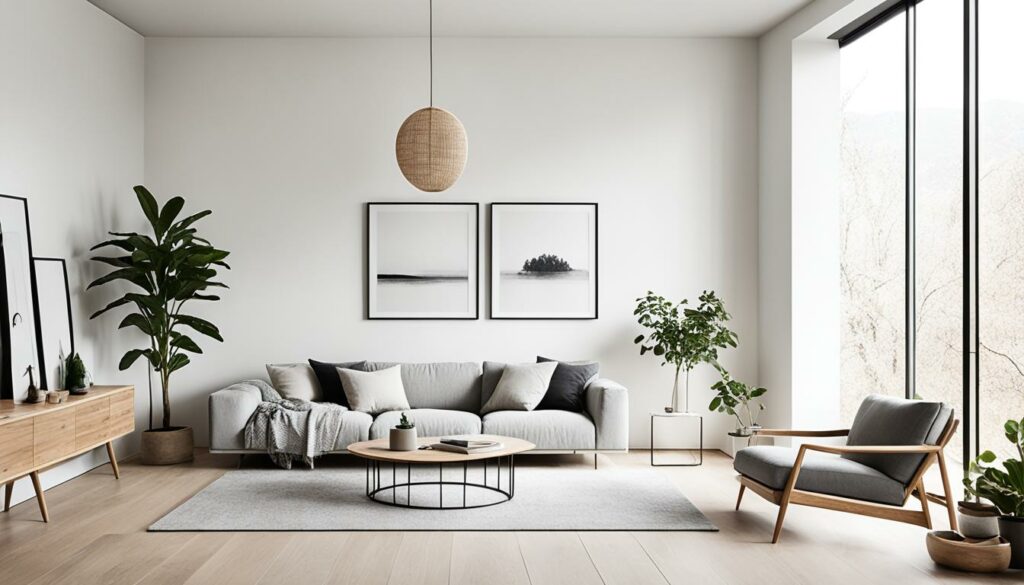
Minimalist Home Characteristics Table
| Characteristic | Description |
|---|---|
| Minimal furniture | Keep furniture to a minimum, opting for functional and simple designs. |
| Clear surfaces | Avoid clutter on surfaces, promoting a sense of openness and tidiness. |
| Accent decorations | Thoughtfully selected decorations that add personality without overwhelming the space. |
| Quality over quantity | Investing in high-quality items that will last longer and maintain their beauty. |
By adhering to these characteristics, you can create a minimalist home that not only looks visually appealing but also promotes a sense of peace and simplicity. Embracing minimalism allows you to curate a space that aligns with your values and creates a calm and clutter-free living environment.
Creating a Minimalist Home: Where to Start
When embarking on the journey of creating a minimalist home, it’s important to start with a clear plan of action. Breaking down the process into manageable steps can make it more achievable and less overwhelming. Here are some practical tips on where to start:
1. Declutter and Simplify Room by Room
Take one room at a time and evaluate each item within. Determine if it serves a purpose or brings you joy. Be mindful of the creating a minimalist home concept and let go of anything that no longer aligns with that vision. This step will help you create a solid foundation for a clutter-free space.
2. Focus on Essential Furniture Pieces
When it comes to furniture, keep only the essential pieces that are functional and necessary for your daily life. Consider versatile pieces that serve multiple purposes, such as a coffee table with built-in storage or a sofa bed for accommodating guests. Embrace simplicity in design and opt for clean lines and neutral colors.
3. Clear Surfaces and Floors
A key aspect of a minimalist home is having clear and uncluttered surfaces and floors. Remove unnecessary items from countertops, shelves, and floors, allowing space for the essential items that truly matter. Store everything out of sight in designated storage areas to maintain a clean and organized look.
4. Keep Decorations and Colors Minimal
Minimalism is all about simplicity and subdued aesthetics. Keep decorations to a minimum, choosing a few key pieces that bring joy and add visual interest to your space. Stick to a subtle color scheme using neutral tones, as they create a calm and harmonious atmosphere.
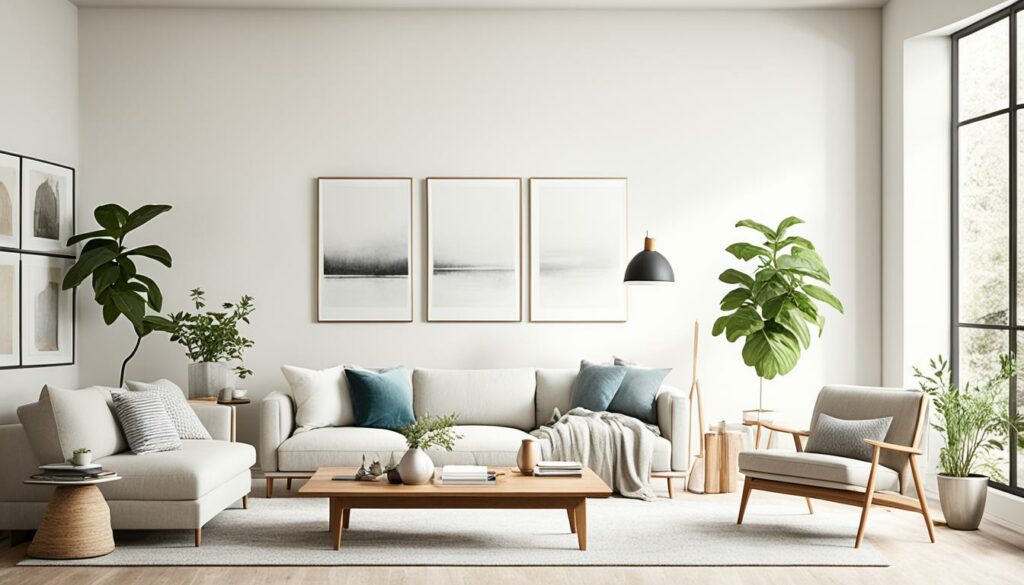
“The ability to simplify means to eliminate the unnecessary so that the necessary may speak.”
– Ava, Celebrity Heaven
By following these initial steps, you’ll be well on your way to creating a minimalist home that reflects your personal style and promotes a sense of tranquility and well-being. Remember, minimalism goes beyond just the physical aspects of your space, it’s a mindset and a lifestyle that encourages intentionality and mindful consumption.
Simplifying Furniture in a Minimalist Home
When it comes to furnishing a minimalist home, simplicity is key. By carefully selecting a few essential and high-quality pieces of furniture, you can create a clean and harmonious living space. The goal is to eliminate unnecessary items and keep the number of furniture pieces to a minimum, allowing for a more spacious and clutter-free environment.
When choosing furniture for a minimalist home, opt for simple designs and solid colors that blend seamlessly with the overall aesthetic. Minimalist furniture often features clean lines and a functional approach, prioritizing both style and comfort. Look for pieces that serve a specific purpose and contribute to the functionality of the space.
One approach to simplifying furniture in a minimalist home is to prioritize multi-functional pieces. For example, a sleek and versatile sofa that can double as a guest bed can save space and serve multiple purposes. Similarly, a coffee table with built-in storage can help keep the living area free from clutter.
Another strategy is to focus on furniture that offers ample storage options, such as dressers or cabinets with clean and minimalistic designs. This allows you to store belongings out of sight, maintaining a tidy and organized appearance.
Remember to consider the scale of furniture in relation to the size of the space. Overly large or bulky pieces can overpower a minimalist room and create a sense of clutter. Instead, opt for furniture that is proportionate to the room and leaves sufficient negative space.
However, simplifying furniture doesn’t mean sacrificing comfort. Invest in high-quality materials and craftsmanship to ensure your furniture not only looks great but also provides lasting comfort and durability. Choose materials such as solid wood or high-quality upholstery that align with the minimalist aesthetic while offering longevity.
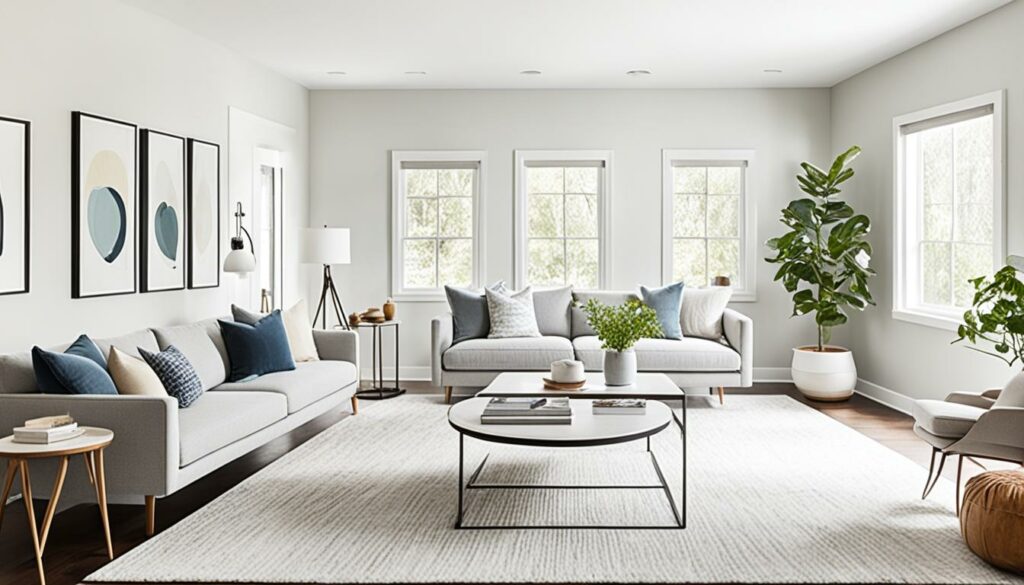
In summary, simplifying furniture in a minimalist home involves selecting a few essential and high-quality pieces, opting for simple designs and solid colors, and prioritizing functionality and comfort. By adopting these principles, you can create a harmonious and clutter-free living space that embodies the essence of minimalism.
Clearing Surfaces and Floors in a Minimalist Home
In a minimalist home, maintaining clean and clutter-free surfaces and floors is essential to create a sense of calm and simplicity. By clearing these areas, we can enhance the visual appeal and overall aesthetic of our living space, promoting a more peaceful environment. Here are some tips to help you effectively clear surfaces and floors:
1. Limit Decorations
When it comes to minimalist design, less is more. Limit the number of decorations you display on flat surfaces such as countertops, tables, and shelves. Opt for one or two simple decorative items that align with your overall aesthetic. This approach allows each piece to stand out and adds visual interest without overwhelming the space.
2. Minimize Knick-Knacks
Avoid accumulating excessive knick-knacks that can contribute to a cluttered look. These small items tend to take up valuable surface space and can create visual noise. Instead, choose a few meaningful items that hold significance to you and display them sparingly.
3. Designated Storage Spaces
Ensure that everything in your minimalist home has its designated storage space. This will help you maintain a clutter-free look on surfaces and floors. Invest in functional storage solutions such as drawers, cabinets, and bins to store items out of sight. By keeping everything organized and stored away, you can easily find what you need while maintaining a visually clean environment.
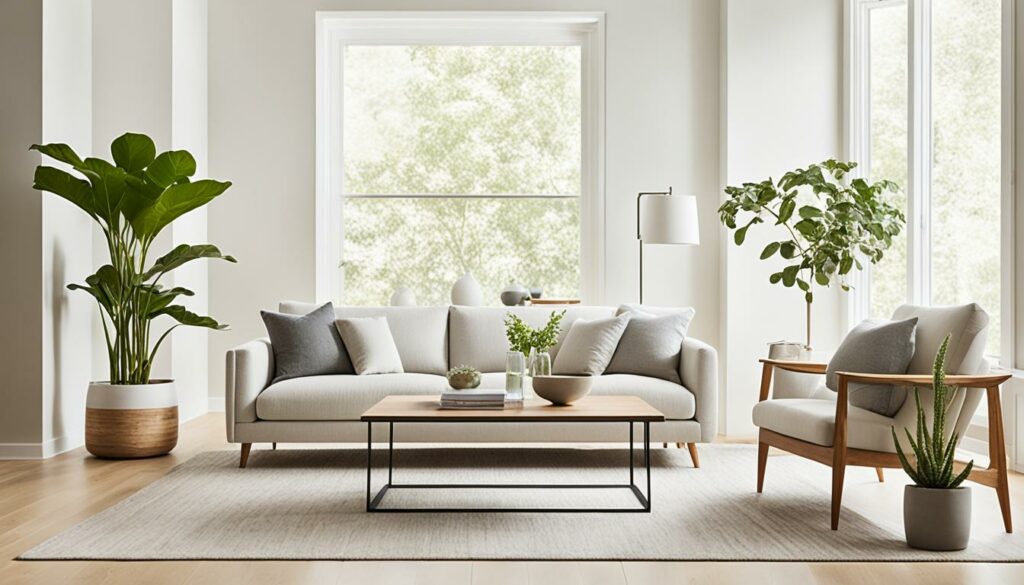
4. Minimize Stacks of Items
Avoid stacking items on surfaces or floors. Piles of books, papers, or miscellaneous objects can quickly accumulate and create visual clutter. Instead, store these items vertically on shelves or in drawers to maintain a tidier appearance.
5. Regular Decluttering
Regularly declutter the surfaces and floors in your minimalist home to prevent the accumulation of unnecessary items. Take the time to evaluate your possessions and let go of those that no longer serve a purpose or hold sentimental value. By adopting a mindful approach to decluttering, you can create a space that is visually appealing and promotes a sense of peace and tranquility.
By following these tips, you can effectively clear surfaces and floors in your minimalist home, creating a clean and clutter-free environment. Embrace the simplicity and elegance of minimalist design, allowing the beauty of your space to truly shine.
Minimalist Artwork and Decorations
When it comes to creating a minimalist home, choosing the right artwork and decorations is crucial. These elements can add personality and visual interest to your space without overwhelming its clean and simple aesthetic. Here are some tips to help you select the perfect minimalist artwork and decorations that will enhance the tranquility and elegance of your home.
1. Less is More
In a minimalist home, it’s important to follow the “less is more” principle when selecting artwork and decorations. Stick to one or two pieces that truly resonate with you and align with your overall design aesthetic. Avoid cluttering your walls or surfaces with excessive artwork that can disrupt the minimalistic vibe.
2. Simple Designs
Opt for artwork and decorations with minimalist designs. Clean lines, geometric shapes, and abstract forms work beautifully in a minimalist space. Choose pieces that evoke a sense of calm and simplicity, complementing the overall ambiance of your home.
3. Subdued Colors
Keep the color palette of your artwork and decorations subdued. Neutral tones like whites, grays, and earthy hues seamlessly blend into a minimalist interior. These colors create a serene and harmonious atmosphere, allowing the focus to remain on the essential elements of your space.
4. Strategic Placement
Consider the placement of your artwork and decorations for maximum impact. Create a focal point by hanging a single piece of artwork on a blank wall or display it on a clean and clear surface. Remember, in a minimalist home, every item should have a purpose and contribute to the overall aesthetic.
5. Balance and Symmetry
Strive for balance and symmetry in your artwork and decorations. Align pieces with the furniture and architectural elements of your space to create a cohesive and harmonious look. Symmetrical arrangements can bring a sense of order and balance to your minimalist home.
By selecting one or two meaningful pieces of artwork and decorations with minimalist designs and subdued colors, you can add a touch of individuality to your minimalist home without compromising its serene and clutter-free ambiance. Let your chosen pieces become subtle accents that enhance the beauty of your space.
| Pros of Minimalist Artwork and Decorations | Cons of Minimalist Artwork and Decorations |
|---|---|
| Enhances the minimalist aesthetic | Limiting options for variety |
| Creates a calming and serene atmosphere | Can be perceived as too simplistic by some |
| Adds a touch of personality and visual interest | Requires careful selection to maintain balance |
| Allows the focus to remain on essential elements | May not suit all individual tastes |
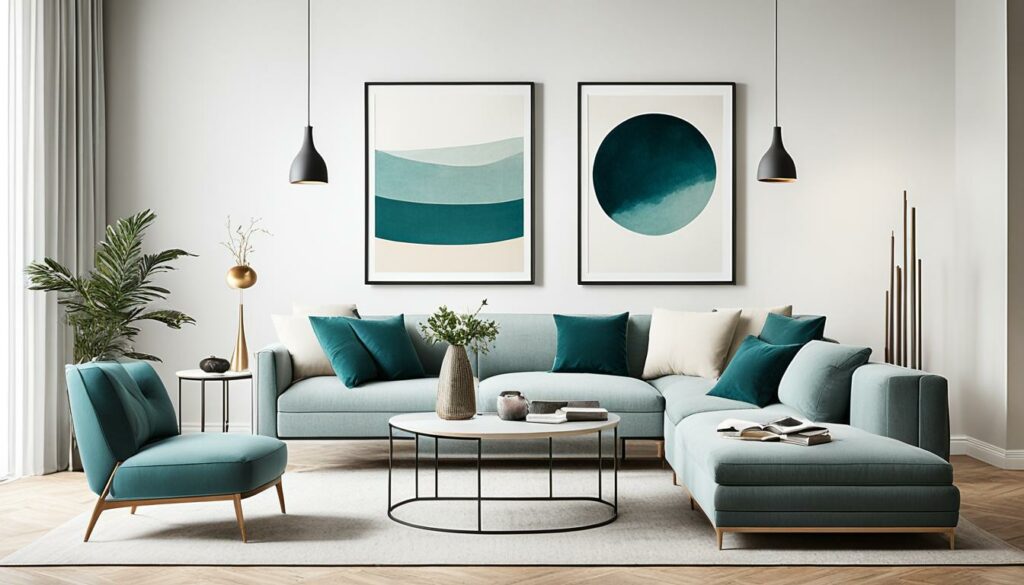
By choosing minimalist artwork and decorations, you can create a harmonious and visually appealing space that reflects your personal style. Remember, the key is to strike a balance between simplicity and self-expression. Let your minimalist home become a sanctuary filled with carefully curated pieces that bring you joy and serenity.
Color and Pattern Choices for a Minimalist Home
When it comes to creating a minimalist home, color and pattern choices play a crucial role. By using a subdued color palette and incorporating minimal patterns, you can enhance the minimalist aesthetic and create a harmonious living space. In this section, we’ll explore popular color choices for a minimalist home and discuss how to effectively incorporate patterns.
Subdued Color Palette
In a minimalist home, neutral colors are the go-to choice for creating a clean and calming atmosphere. Shades of white, beige, taupe, and light gray are excellent options to consider. These neutral tones provide a versatile backdrop that allows other elements in your home to shine. They also help to maximize natural light and create a sense of spaciousness.
When selecting colors for your minimalist home, it’s important to rely on a cohesive color scheme throughout the space. This creates a sense of unity and enhances the overall minimalist design. Consider using a limited color palette and sticking to shades that complement each other.
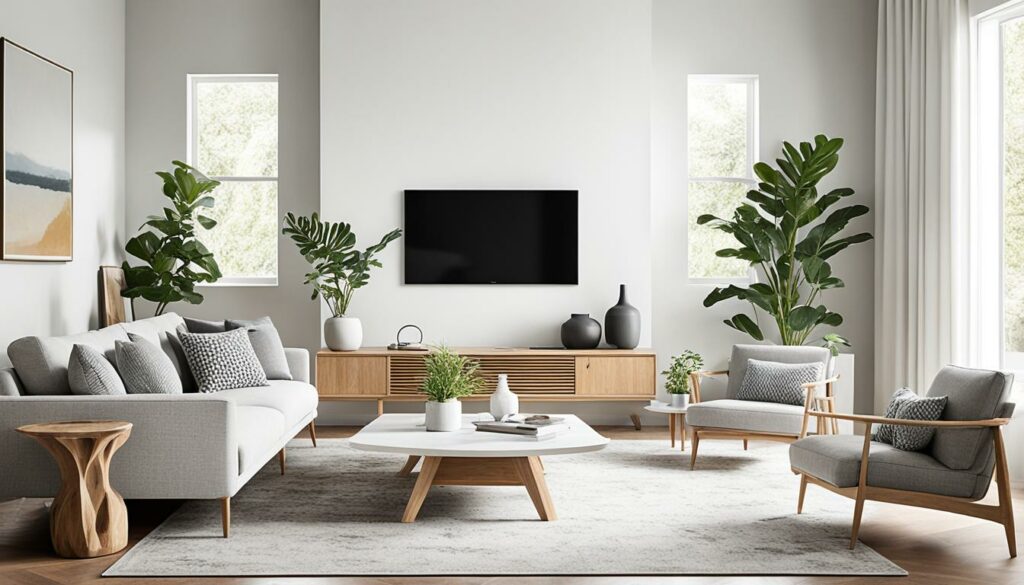
Incorporating Patterns
While minimalism typically emphasizes simplicity, there is room for subtle patterns in a minimalist home. When it comes to patterns, less is more. Instead of overwhelming the space with bold and busy patterns, opt for delicate and understated designs.
One effective way to incorporate patterns is through easily changeable items such as artwork and rugs. A simple patterned rug can add visual interest to a minimalist space without overpowering the overall design. Likewise, a piece of artwork with a subtle pattern can serve as a focal point and create a sense of depth.
“By using minimal patterns strategically, you can add texture and visual appeal without compromising the simplicity of your minimalist home.” – Interior Design Expert, Harper, Editor-in-Chief
Color and Pattern Combinations
| Color Combination | Pattern |
|---|---|
| White and Light Gray | Geometric |
| Beige and Taupe | Subtle Stripes |
| White and Cream | Herringbone |
When incorporating patterns, remember to maintain a balance between simplicity and visual interest. Keep the patterns minimal and let them complement the overall minimalist design of your home.
With the right color and pattern choices, you can create a minimalist home that is visually appealing, calming, and reflective of your personal style.
Storage and Organization in a Minimalist Home
When it comes to creating a minimalist home, maintaining proper storage and organization is key. By ensuring that everything has its designated space, you can maintain the clean and clutter-free aesthetic that minimalist design is known for.
In a minimalist home, it’s essential to keep items out of sight and have a place for everything. This not only helps to reduce visual distractions but also promotes a sense of order and efficiency. Utilizing drawers, cabinets, and bookshelves can help you store your belongings in a tidy and organized manner.
When organizing your minimalist home, it’s important to aim for logical storage spots. Consider storing items close to where they are used for added convenience. For example, store cooking utensils and ingredients near the stove, or keep office supplies near your workspace. By doing so, you can easily access what you need without adding unnecessary clutter to other areas of your home.
Having a well-organized minimalist home not only contributes to its overall aesthetic but also enhances functionality. You’ll be able to find what you need when you need it, helping to streamline your daily routines and reduce stress.
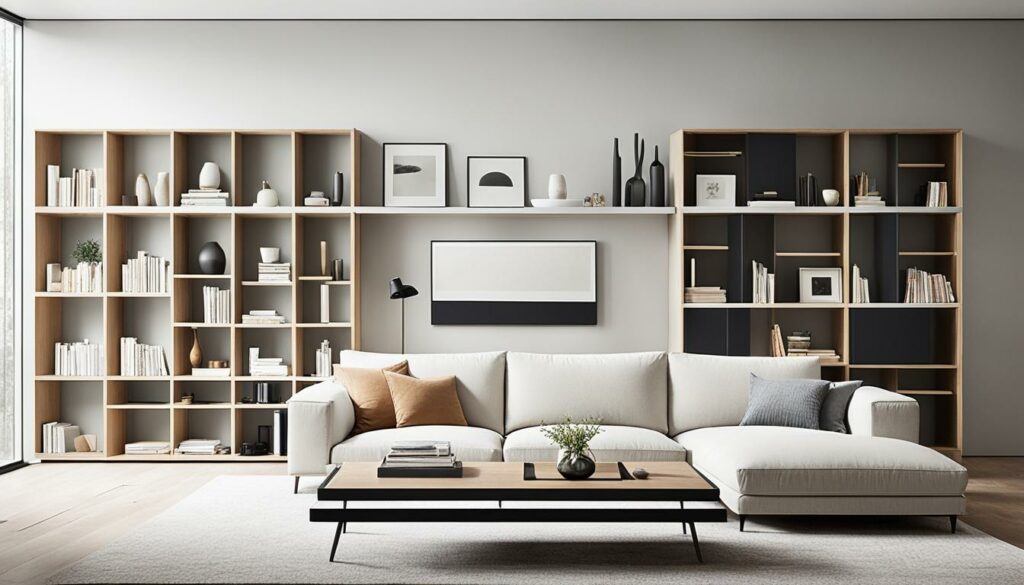
Benefits of Proper Storage and Organization
The benefits of proper storage and organization in a minimalist home are numerous. Here are a few advantages:
Efficiency: With everything in its designated place, you can easily locate and retrieve items, saving you time and effort.
Visual Clarity: A clutter-free environment promotes a sense of calm and relaxation, allowing you to fully enjoy the beauty of your minimalist home.
Mental Peace: By eliminating visual distractions and reducing clutter, you create a serene atmosphere that can contribute to a peaceful state of mind.
Simplicity: Proper storage and organization align with the core principles of minimalism, allowing you to focus on what truly matters and eliminate excess.
By integrating these principles of storage and organization into your minimalist home, you can create a space that is both visually appealing and highly functional. Having a designated place for everything ensures that your belongings are easily accessible when you need them, while maintaining the clean and clutter-free aesthetic that minimalist design embodies.
| Storage and Organization Tips for a Minimalist Home |
|---|
| 1. Declutter regularly to eliminate unnecessary items and create a sense of spaciousness. |
| 2. Invest in multi-functional furniture with built-in storage options. |
| 3. Use labels or dividers to clearly identify the contents of drawers and cabinets. |
| 4. Consider vertical storage solutions such as wall shelves or hanging organizers to maximize space. |
| 5. Group similar items together for easy access and a streamlined look. |
By following these storage and organization tips, your minimalist home will not only look tidy and organized but also function efficiently, promoting a sense of tranquility and well-being.
Maintaining Minimalism in a Home
Once you have achieved a minimalist home, it is important to maintain the simplicity and clutter-free environment. By regularly decluttering and evaluating your possessions, you can ensure that your home remains minimalist and free from unnecessary items.
Edit and eliminate any items throughout the house that do not serve a purpose or bring you joy. Take a critical look at each item and consider if it aligns with your minimalist lifestyle. Remember, less is more in a minimalist home, and every item should have a specific purpose or value.
Find a place for everything and make a conscious effort to keep everything in its designated spot. This prevents items from accumulating in random places and helps maintain a neat and organized space. Invest in storage solutions that keep items hidden and out of sight, such as baskets, bins, and shelves.
Adopt a conscious approach when acquiring new items to prevent clutter from building up. Before making a purchase, ask yourself if it is truly necessary and if it aligns with your minimalist values. Consider the long-term value and functionality of the item, rather than succumbing to impulsive buying habits.
Remember, maintaining minimalism in a home is an ongoing process. It requires regular evaluation, decluttering, and conscious decision-making. By following these tips, you can create a harmonious and clutter-free living space that promotes tranquility and well-being.
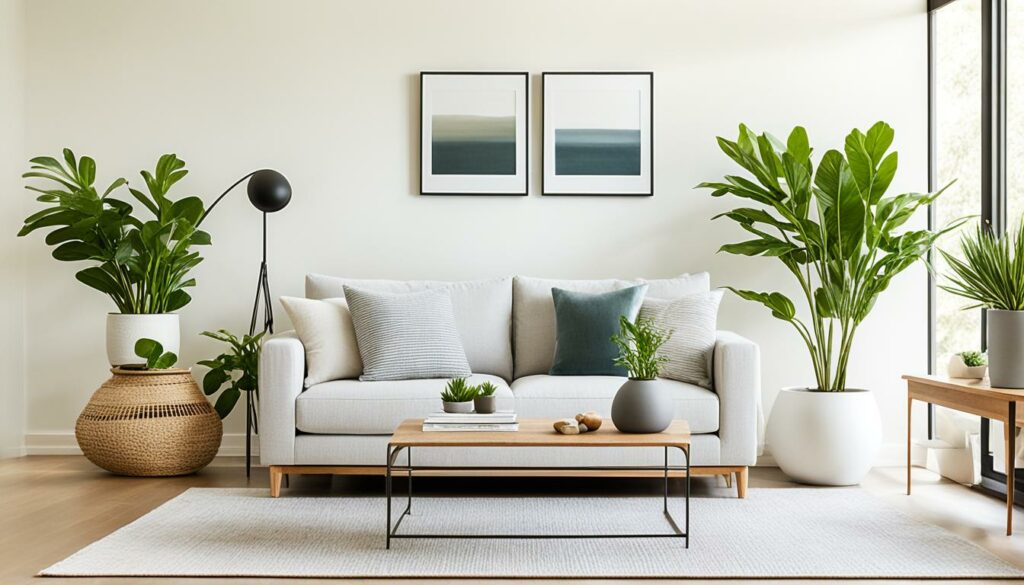
| Benefits of Maintaining Minimalism in a Home | Key Strategies for Maintenance |
|---|---|
| 1. Clutter-free environment | 1. Regular decluttering and editing |
| 2. Enhanced tranquility | 2. Finding a place for everything |
| 3. Increased organization | 3. Adopting a conscious approach to acquiring new items |
| 4. Improved focus and productivity | |
| 5. Stress reduction |
Note: The table above highlights the benefits of maintaining minimalism in a home and provides key strategies for effectively maintaining a minimalist living environment.
Minimalist Window Treatments and Wall Decor
When it comes to minimalist design, even the smallest details matter. Window treatments and wall decor play a significant role in creating a clean, uncluttered aesthetic in your space. By incorporating plain and simple window treatments and embracing minimalism in your wall decor, you can enhance the overall minimalist vibe of your home.
Minimalist Window Treatments
Window treatments serve both functional and aesthetic purposes in a room. In a minimalist home, it’s essential to choose window treatments that seamlessly blend into the overall design while providing privacy and light control. Opt for solid-colored curtains or wooden blinds that have clean lines and simple designs. These types of window treatments not only complement the minimalistic style but also create a sense of tranquility and serenity.
Plain curtains in neutral tones like whites, greys, or pastels can add an elegant touch to your minimalist living space. The simplicity of their design allows natural light to flow through, emphasizing the clean lines and open atmosphere of the room. Wooden blinds, on the other hand, offer a sleek and contemporary look that effortlessly integrates with minimalist interior design.
By choosing minimalist window treatments, you can maintain a sense of tranquility and openness in your space, allowing the other elements of your minimalist design to shine.
Embracing Minimalism in Wall Decor
When it comes to wall decor in a minimalist home, less is more. Keeping the walls clear of excessive decorations helps create an uncluttered and serene ambiance. Instead of covering every inch of wall space, opt for one or two simple pieces of artwork that reflect your personal style. Choose pieces with minimalistic designs, subtle colors, and clean lines to add visual interest without overwhelming the space.
| Table: Tips for Minimalist Wall Decor |
|---|
| 1. Choose artwork with minimalist designs and subtle colors. |
| 2. Hang one or two pieces of artwork as focal points in your room. |
| 3. Keep frames simple, opting for sleek designs or natural materials like wood. |
| 4. Consider using large mirrors to create the illusion of space and reflect natural light. |
| 5. Use wall shelves to display a few carefully curated objects that align with your minimalist aesthetic. |
Remember, the goal is to maintain a sense of simplicity and openness while still incorporating elements of personal style. By embracing minimalism in your window treatments and wall decor, you can create a harmonious and visually appealing living space that reflects your minimalist lifestyle.
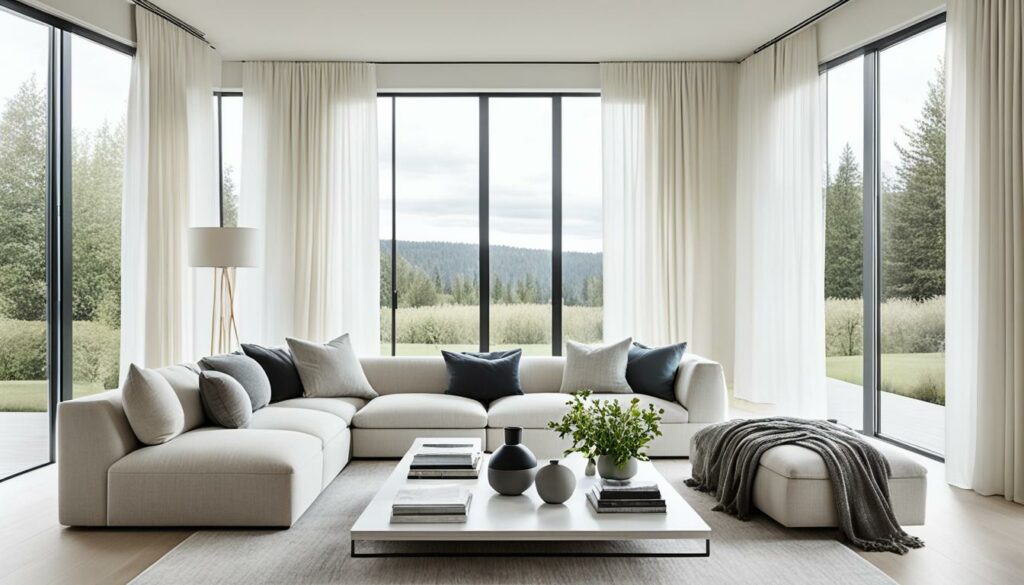
Embracing Minimalism: Less is More
In a minimalist home, embracing the concept of less is more is key. By focusing on quality over quantity, you can create a space that reflects your personal style and promotes a sense of tranquility and fulfillment.
When it comes to embracing minimalism, it’s important to choose items that you truly love and use frequently. By eliminating unnecessary clutter and visual distractions, you can create a more calming and inviting living space.
As the famous architect Ludwig Mies van der Rohe once said, “Less is more.” This principle encapsulates the essence of minimalism. By paring down your belongings and keeping only what is essential, you can create a sense of spaciousness and elegance in your home.
By adopting a minimalist mindset, you can free yourself from the burden of excess possessions and focus on what truly matters. Consider the following tips for embracing minimalism:
1. Declutter Regularly
Regularly decluttering your space is essential to maintaining a minimalist home. Take the time to evaluate your belongings and let go of items that no longer serve a purpose or bring you joy. Streamlining your possessions will not only create a more visually pleasing environment, but it will also make it easier to keep your home clean and organized.
2. Focus on Quality
When selecting items for your minimalist home, prioritize quality over quantity. Choose pieces that are well-crafted and built to last. Invest in furniture, decor, and other essentials that you truly love and that align with your personal style. By carefully curating your belongings, you can create a space that feels intentional and refined.
3. Keep It Simple
Minimalism is all about simplicity. Opt for clean lines, neutral colors, and uncluttered spaces. Avoid excessive ornamentation and decorative flourishes. Instead, let the beauty of each individual piece shine through. By embracing simplicity in your design choices, you can create a space that feels harmonious and peaceful.
| Benefits of Embracing Minimalism | Less is More Principles in Practice |
|---|---|
| 1. Reduced stress and mental clutter | 1. Embrace minimal furniture and clear surfaces to create a clean and uncluttered look. |
| 2. Increased focus and productivity | 2. Choose quality over quantity when selecting items for your minimalist home. |
| 3. Enhanced visual appeal and simplicity | 3. Keep it simple by opting for clean lines, neutral colors, and uncluttered spaces. |
| 4. Easier maintenance and cleaning | 4. Regularly declutter and evaluate your possessions to maintain a minimalist home. |
Embracing minimalism is not about depriving yourself of belongings, but rather about curating a space that truly reflects your values and brings you joy. By embracing the “less is more” philosophy, you can create a minimalist home that is both visually appealing and personally fulfilling.
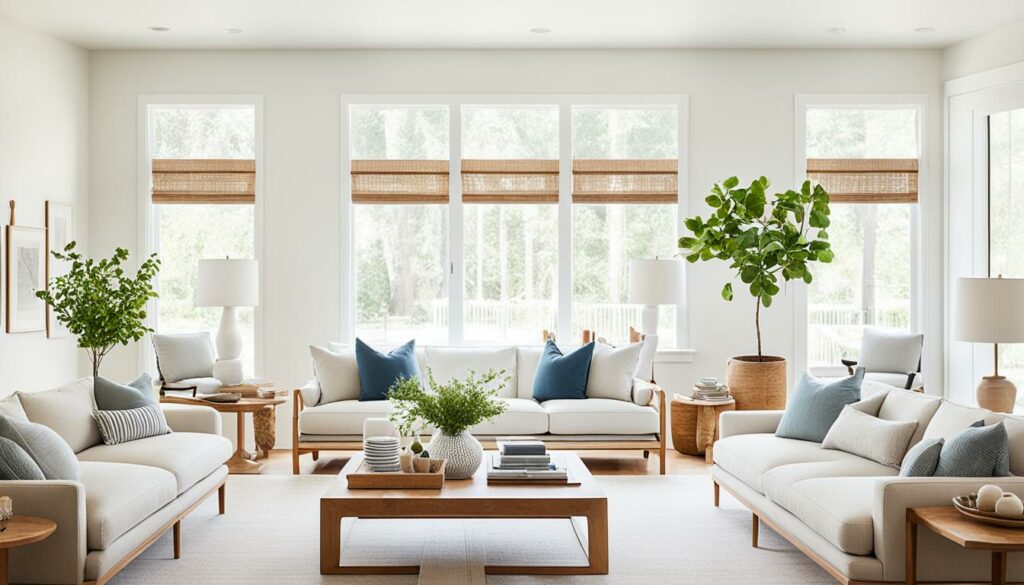
Conclusion
Minimalist living rooms offer a range of styles that focus on the essential. Embracing simplicity and elegance, these rooms create a calming and clutter-free environment. By following the principles of minimalist design, we can create a minimalist living room that reflects our personal style while promoting a sense of tranquility and well-being.
In minimalist living rooms, the emphasis is on quality over quantity, with carefully chosen furniture and simple, yet impactful, decorations. The use of neutral palettes and clean lines creates a soothing atmosphere, allowing us to relax and unwind.
Whether you prefer a minimalist living room with a Scandinavian-inspired look or a modern minimalist aesthetic, the key is to declutter and create a space that truly reflects your personal style. By incorporating the principles of minimalism, we can enjoy a living room that not only looks beautiful but also fosters a sense of calm and balance in our daily lives.
